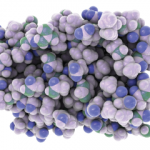 ACR Convergence 2020—The types of autoinflammatory and rheumatic diseases that may be effectively treated by blocking type 1 interferon (IFN) are growing as more is understood about IFN signaling as a pathomechanism amplifying immune dysregulation in a range of clinical diseases.1–3 In a session titled Interfering with Interferon, investigators from the U.S. National Institutes of Health (NIH) described key features and genetic causes of Mendelian interferonopathies and treatment approaches that may indicate the efficacy of IFN inhibition, such as with Janus kinase inhibitors (JAKinibs).
ACR Convergence 2020—The types of autoinflammatory and rheumatic diseases that may be effectively treated by blocking type 1 interferon (IFN) are growing as more is understood about IFN signaling as a pathomechanism amplifying immune dysregulation in a range of clinical diseases.1–3 In a session titled Interfering with Interferon, investigators from the U.S. National Institutes of Health (NIH) described key features and genetic causes of Mendelian interferonopathies and treatment approaches that may indicate the efficacy of IFN inhibition, such as with Janus kinase inhibitors (JAKinibs).
Raphaela Goldbach-Mansky, MD, MHS, a senior investigator in the Translational Autoinflammatory Diseases Section in the National Institute of Allergy and Infectious Diseases (NIAID), spoke on a group of model diseases that illustrate the spectrum of clinical features associated with a chronically elevated IFN signature.4 Falling under the general category of autoinflammatory Mendelian interferonopathies, these include SAVI (STING-associated vasculopathy with onset in infancy), CANDLE (chronic atypical neutrophilic dermatosis with lipodystrophy and elevated temperatures) and AGS (Aicardi-Goutières syndrome).
She discussed a set of clinical features of these diseases that may indicate type 1 IFN as a potential pathomechanism, including neutrophilic rashes (particularly neutrophilic panniculitis), lipodystrophy, vasculopathies (e.g., chilblain lesions), interstitial lung disease, primary pulmonary hypertension, myositis, neurological findings (e.g., encephalopathy) and imaging findings (e.g., basal ganglia calcifications or leukoencephalopathy).
“Such findings in patients with inflammatory diseases even in the absence of disease-causing mutations should prompt the investigation for an interferon-mediated disease process,” said Dr. Goldbach-Mansky. “Unfortunately, tests that probe for an IFN signature are not yet clinically available but would significantly enhance our diagnostic armamentarium.”
Dr. Goldbach-Mansky also described conditions that can mimic these diseases and that also show IFN dysregulation, such as spondyloenchondrodysplasia, deficiency of adenosine deaminase 2 for SAVI or trichohepatoenteric syndrome for AGS. Other conditions (e.g., NEMO-exon 5 deletion autoinflammatory syndrome, which mimics CANDLE) are novel diseases that have a more complex inflammatory signature that includes IFN signaling. “Knowing the genetic mutations will help in further studying pathways and finding targets for treatment of more complex diseases,” she said.
‘Unfortunately, tests that probe for an IFN signature are not yet clinically available.’ —Dr. Goldbach-Mansky
She underscored the promise of these findings for improving treatment. “With the increasing number of agents that target IFN signaling, including JAK inhibitors, antibodies to the IFN receptor and [future] STING inhibitors, there is light at the end of the tunnel with better treatment options on the horizon not only for patients with rare autoinflammatory diseases, but also for patients with complex diseases caused by IFN dysregulation,” she said.
Dr. Goldbach-Mansky recommended safety monitoring of JAKinibs, including infections (e.g., viral reactivation, BK virus and varicella zoster), infection resolution and cytopenias (e.g., anemia at higher doses).
Juvenile Dermatomyositis
Hanna Kim, MS, MD, an assistant clinical investigator at the National Institutes of Arthritis and Musculoskeletal and Skin Diseases (NIAMS), followed up by talking about juvenile dermatomyositis (JDM) and its overlap with CANDLE and SAVI interferonopathies. “JDM is a less rare complex condition (i.e., not caused by a single genetic mutation) that interestingly shares not only an increase in interferon signature, but some clinical features [as well], such as myositis, calcinosis, skin ulcers and lipodystrophy, with CANDLE and/or SAVI,” she said.
This overlap, she said, indicates treatments that block IFN signaling (e.g., JAKinibs) may also work for JDM.
Preliminary data support this theory. Dr. Kim described data from several case reports and case series showing clinical improvement in skin disease (and some improvement in weakness) with JAKinibs in refractory adult dermatomyositis and juvenile dermatomyositis.5–7 She also cited data showing improvement in lung disease and calcinosis in a subset of pateints.8–12
“Preliminary, limited, open-label data thus far in refractory JDM indicate clinical improvement with JAK inhibitors,” she said. “Further evaluation of JAK inhibitors is warranted as a promising treatment in JDM.”
Mary Beth Nierengarten is a freelance medical journalist based in Minneapolis.
References
- Montealegre Sanchez GA, Reinhardt A, Ramsey S, et al. JAK1/2 inhibition with baricitinib in the treatment of autoinflammatory interferonopathies: Results from a compassionate use program. J Clin Invest. 2018 Jul 2;128(7):3041–3052.
- Vanderver A, Adang L, Gavazzi F, et al. Janus kinase inhibition in the Aicardi-Goutières syndrome. N Engl J Med. 2020 Sep 3;383(10):986–989.
- Kim H, Brooks K, Tang CC, et al. Pharmacokinetics and pharmacodynamics of the oral JAK1 and JAK2 inhibitor baricitinib in pediatric patients with CANDLE and SAVI. (2017) Clin Pharmacol Ther. 2018 Aug;104(2):364–373.
- Kim H, de Jesus AA, Brooks SR, et al. Development of a validated IFN Score using NanoString technology. J Interferon Cytokine Res. 2018 Apr;38(4):171–185.
- Aeschmann FA, Fremond ML, Duffy D, et al. A child with severe juvenile dermatomyositis treated with ruxolitinib. Brain. 2018 Nov 1;141(11):e8.
- Papadopoulou C, Hong Y, Omoyinmi E, et al. Janus kinase ½ inhibition with baricitinib in the treatment of juvenile dermatomyositis. Brain. 2019 Mar 1;142(3):e8.
- Kim H, Dill S, O’Brien M, et al. Janus kinase (JAK) inhibition with baricitinib in refractory juvenile dermatomyositis. Ann Rheum Dis. 2020 Aug. Epub ahead of print.
- Kurasawa K, Arai S, Namiki Y, et al. Tofacitinib for refractory interstitial lung disease in anti-melanoma differentiation-associated 5 gene antibody-positive dermatomyositis. Rheumatology (Oxford). 2018 Dec 1;57(12):2114–2119.
- Chen Z, Wang X, Ye S. Tofacitinib in amyopathic dermatomyositis-associated interstitial lung disease. N Engl J Med. 2019 July 18;3813(3):291–293.
- Kato M, Ikeda K, Kageyama T, et al. Successful treatment for refractory interstitial lung disease and pneumomediastinum with multidisciplinary therapy including tofacitinib in patients with anti-MDA5 antibody-positive dermatomyositis. J Clin Rheumatol. 2019 Jan 4. Epub ahead of print.
- Ishikawa Y, Kasuya T, Fujiwara M, et al. Tofacitinib for recurrence of antimelanoma differentiation-associated gene 5 antibody-positive clinically amyopathic dermatomyositis after remission. Medicine (Baltimore). 2020 Sept 11;99(37):e21943.
- Sabbagh S, de Jesus AA, Hwang SJ, et al. Treatment of anti-MDA5 autoantibody-positive juvenile dermatomyositis using tofacitinib. Brain. 2019 Nov 1;142(11):e59.




